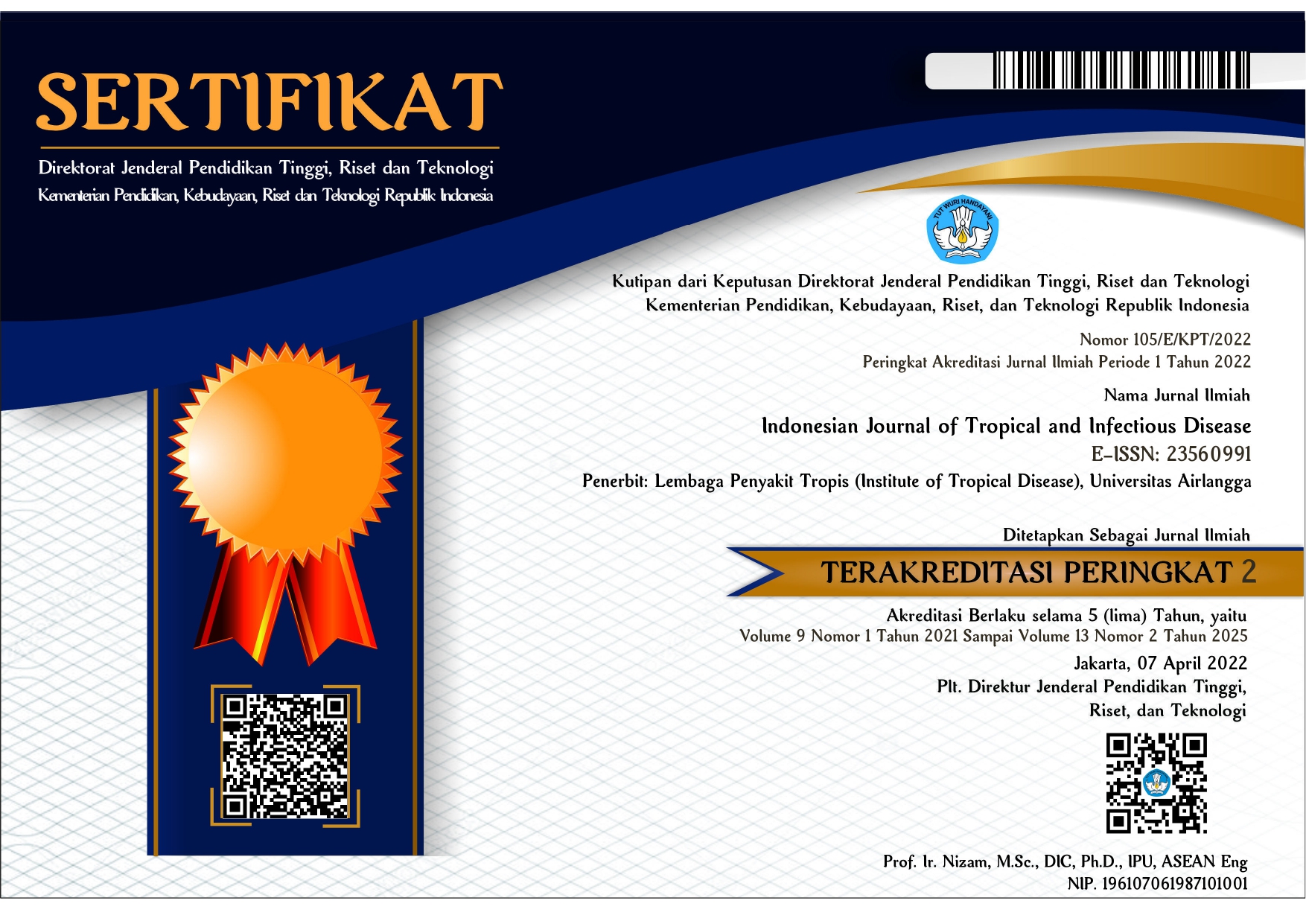Current Profile of Vivax Malaria in Isolated Area of Kualuh Leidong
Downloads
The Indonesian Ministry of Health targets to eliminate malaria by 2030. Vivax malaria, a challenging variant to eradicate, is prevalent in areas near elimination, including North Sumatra, which ranks fourth in malaria cases in Indonesia. Labura district, a part of North Sumatra, had a low-endemic status until 2020. However, an increase in cases occurred in 2021 within the Kualuh Leidong subdistrict, the primary contributor to Labura's malaria cases. This shifted the endemicity status from low to moderate. The objective of the study is to assess the malaria case profile in this region. A descriptive approach was used, employing a total sampling method at Tanjung Leidong Health Center between September 2022 and July 2023. This observational study identified 494 vivax malaria cases. Predominantly affecting males (60.9%), cases peaked in adults (>18 years) with 314 cases (63.6%). Microscopic examination was the leading diagnostic tool, used in 463 cases (93.7%). The health center primarily administered national regimen therapies dihydroartemisinin-piperaquine (DHP) + primaquine in 204 cases (62.4%), whereas others received alternate therapies. All patients recovered without referrals. Over 11 months, seven recurrence cases emerged, with five receiving quinine+primaquine. Vivax malaria cases in Kualuh Leidong have seen a significant increase compared to previous years. The attention and collaboration of all parties, both from the health center and the community, are necessary to achieve malaria elimination by 2030.
World Health Organization. World malaria report 2020: 20 years of global progress and challenges. Geneva: World Health Organization; 2020.
Ministry of Health of The Republic of Indonesia. National Action Plan for Acceleration of Malaria Elimination 2020-2024. Jakarta; 2020.
World Health Organization. World health statistics 2022: monitoring health for the SDGs, sustainable development goals. Geneva: World Health Organization; 2022.
KEMENKES. Laporan Situasi Terkini Perkembangan Program Pengendalian Malaria di Indonesia Tahun 2022. Jakarta; 2022.
Badan Pusat Statistik. Kualuh Leidong Sub District in Figures. Labuhanbatu Utara: BPS-Statistics of Labuhanbatu Utara District; 2021.
Philothra BD, Alona I, Situmorang E, Limbardon P, Salsalina VG. Treatment-seeking behavior for malaria among communities in Indonesia: A systematic review. Narra J. 2023; Dec;3(3):e428.
Tafesse T, Desalegn R, Dereje A, Tolera C, Desalegn D, Amenu D. Trends of malaria cases (plasmodium species) in Gute Health Center, Wayu Tuka District, East Wollega Zone, (2013-2022): A cross-sectional study. Health Sci Rep. 2024; May 23;7(5):e2156.
Quaresima V, Agbenyega T, Oppong B, Awunyo JADA, Adomah PA, Enty E, et al. Are Malaria Risk Factors Based on Gender? A Mixed-Methods Survey in an Urban Setting in Ghana. Trop Med Infect Dis. 2021; 6(3):161.
Okiring J, Epstein A, Namuganga JF, Kamya EV, Nabende I, Nassali M, et al. Gender difference in the incidence of malaria diagnosed at public health facilities in Uganda. Malar J. 2022; 21(1):22.
Dayananda KK, Achur RN, Gowda DC. Epidemiology, drug resistance, and pathophysiology of Plasmodium vivax malaria. J Vector Borne Dis. 2018; 55(1):1-8.
Abossie A, Getachew H, Demissew A, Habtamu K, Tsegaye A, Zhong D, et al. Profiling vivax malaria incidence, residual transmission, and risk factors using reactive case detection in low transmission settings of Ethiopia. Malar J. 2024; 23:362.
KEMENKES. Buku Saku Tatalaksana Kasus Malaria. Jakarta; 2020.
Koko LPK, Singh V. Burden and clinical characteristics of recurrent Plasmodium vivax infections, and impact of primaquine for radical cure: a systematic scoping review in India. Front. Malar. 2024;1-19.
KEMENKES. Keputusan Menteri Kesehatan Republik Indonesia Tentang Pedoman Nasional Pelayanan Kedokteran Tatalaksana Malaria. Jakarta; 2019.
Kessler A, Shylla B, Singh US, Lyngdoh R, MMawkhlieng B, Eijk AM, et al. Spatial and temporal village-level prevalence of Plasmodium infection and associated risk factors in two districts of Meghalaya, India. Malar J. 2021;20:70.
Kessler A, Eijk AM, Jamir L, Walton C, Carlton JM, Albert S. Malaria in Meghalaya: a systematic literature review and analysis of data from the National Vector-Borne Disease Control Programme. Malar J. 2018;17:411.
Lindblade KA, Hong LX, Tiffany A, Galappaththy, Alonso P, et al. Supporting countries to achieve their malaria elimination goals: the WHO E-2020 initiative. Malar J. 2021;20:481.
Angrisano F, Robinson LJ. Plasmodium vivax – How hidden reservoirs hinder global malaria elimination. Parasitology International. 2022; 87: 102526.
Gavi S, Tapera O, Mberikunashe J, Kanyangarara. Malaria incidence and mortality in Zimbabwe during the COVID-19 pandemic: analysis of routine surveillance data. Malar J. 2021;20:233.
White NJ, Day NP, Ashley EA, Smithuis FM, Nosten FH. Have we really failed to roll back malaria?. The Lancet. 2022;399:799-800.
Noor AM, Alonso PL. The message on malaria is clear: progress has stalled. Lancet. 2022;399:1777.
World Health Organization. World Malaria Report 2022. Geneva: World Health Organization; 2022.
Penjor K, Tobgyal, Zangpo T, Clements ACA, Gray DJ, Wangdi K. Has COVID19 derailed Bhutan’s national malaria elimination goal? A commentary. Malar J. 2021;20:20.
Congressional Research Service. COVID-19: China Medical Supply Chains and Broader Trade Issues. Congressional Research Service; 2020.
Economic Commission for Latin America and the Caribbean. United States supply chains resiliency: the key role Latin America and the Caribbean could play. Washington D.C.: Economic Commission for Latin America and the Caribbean; 2021.
Miller HI, Cohrssen JJ. China's Coronavirus-Induced Paralysis Threatens U.S. Drug Supply Chain. Mo Med. 2020; 117(2):86-88.
Copyright (c) 2025 Indonesian Journal of Tropical and Infectious Disease

This work is licensed under a Creative Commons Attribution-NonCommercial-ShareAlike 4.0 International License.
The Indonesian Journal of Tropical and Infectious Disease (IJTID) is a scientific peer-reviewed journal freely available to be accessed, downloaded, and used for research. All articles published in the IJTID are licensed under the Creative Commons Attribution-NonCommercial-ShareAlike 4.0 International License, which is under the following terms:
Attribution ” You must give appropriate credit, link to the license, and indicate if changes were made. You may do so reasonably, but not in any way that suggests the licensor endorses you or your use.
NonCommercial ” You may not use the material for commercial purposes.
ShareAlike ” If you remix, transform, or build upon the material, you must distribute your contributions under the same license as the original.
No additional restrictions ” You may not apply legal terms or technological measures that legally restrict others from doing anything the license permits.























